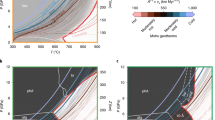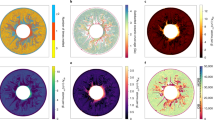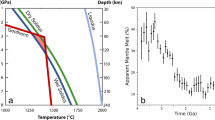Abstract
Because of their distinct chemical signatures, ocean-island and mid-ocean-ridge basalts are traditionally inferred to arise from separate, isolated reservoirs in the Earth's mantle. Such mantle reservoir models, however, typically satisfy geochemical constraints, but not geophysical observations. Here we propose an alternative hypothesis that, rather than being divided into isolated reservoirs, the mantle is filtered at the 410-km-deep discontinuity. We propose that, as the ascending ambient mantle (forced up by the downward flux of subducting slabs) rises out of the high-water-solubility transition zone (between the 660 km and 410 km discontinuities) into the low-solubility upper mantle above 410 km, it undergoes dehydration-induced partial melting that filters out incompatible elements. The filtered, dry and depleted solid phase continues to rise to become the source material for mid-ocean-ridge basalts. The wet, enriched melt residue may be denser than the surrounding solid and accordingly trapped at the 410 km boundary until slab entrainment returns it to the deeper mantle. The filter could be suppressed for both mantle plumes (which therefore generate wetter and more enriched ocean-island basalts) as well as the hotter Archaean mantle (thereby allowing for early production of enriched continental crust). We propose that the transition-zone water-filter model can explain many geochemical observations while avoiding the major pitfalls of invoking isolated mantle reservoirs.
This is a preview of subscription content, access via your institution
Access options
Subscribe to this journal
Receive 51 print issues and online access
$199.00 per year
only $3.90 per issue
Buy this article
- Purchase on SpringerLink
- Instant access to full article PDF
Prices may be subject to local taxes which are calculated during checkout



Similar content being viewed by others
References
Grand, S. Mantle shear structure beneath the americas and surrounding oceans. J. Geophys. Res. 99, 11591–11621 (1994)
van der Hilst, R., Widiyantoro, S. & Engdahl, E. Evidence for deep mantle circulation from global tomography. Nature 386, 578–584 (1997)
Masters, G., Laske, G., Bolton, H. & Dziewonski, A. in Earth's Deep Interior (eds Karato, S., Forte, A., Liebermann, R., Masters, G. & Stixrude, L.) 63–87 (AGU, Washington DC, 2000)
van Keken, P., Hauri, E. & Ballentine, C. Mantle mixing: The generation, preservation, and destruction of chemical heterogeneity. Annu. Rev. Earth Planet. Sci. 30, 493–525 (2002)
Hofmann, A. & White, W. The role of subducted oceanic crust in mantle evolution. Carnegie Inst. Wash. Yearbk. 79, 477–483 (1980)
Coltice, N. & Ricard, Y. Geochemical observations and one layer mantle convection. Earth Planet. Sci. Lett. 174, 125–137 (1999)
Kellogg, L., Hager, B. & van der Hilst, R. Compositional stratification in the deep mantle. Science 283, 1881–1884 (1999)
Dziewonski, A. & Anderson, D. Preliminary reference earth model. Phys. Earth Planet. Inter. 25, 297–356 (1981)
Kennet, B. & Engdahl, E. Travel times for global earthquake location and phase identification. Geophys. J. Int. 105, 429–466 (1991)
Davaille, A. Simultaneous generation of hotspots and superswells by convection in a heterogeneous planetary mantle. Nature 402, 756–760 (1999)
Tackley, P. Strong heterogeneity caused by deep mantle layering. Geochem. Geophys. Geosyst. 3, 10.1029/2001GC000167 (2002)
Schubert, G., Turcotte, D. & Olson, P. Mantle Convection in the Earth and Planets (Cambridge Univ. Press, Cambridge, UK, 2001)
Ringwood, A. Phase transformations and their bearings on the constitution and dynamics of the mantle. Geochem. Cosmochem. Acta 55, 2083–2110 (1991)
Williams, Q. & Hemley, R. Hydrogen in the deep earth. Annu. Rev. Earth. Planet. Sci. 29, 365–418 (2001)
Chakraborty, S. et al. Enhancement of cation diffusion rates across the 410-kilometer discontinuity in earth's mantle. Science 283, 362–365 (1999)
Xu, Y., Poe, B., Shankland, T. & Rubie, D. Electrical conductivity of olivine, wadsleyite, and ringwoodite under upper-mantle conditions. Science 280, 1415–1418 (1998)
Kohlstedt, D., Keppler, H. & Rubie, D. Solubility of water in the α, β and γ phases of (Mg, Fe)2SiO4 . Contrib. Mineral. Petrol. 123, 345–357 (1996)
Bolfan-Casanova, N., Keppler, H. & Rubie, D. Water partitioning between nominally anhydrous minerals in the MgO–SiO2–H2O system up to 24GPa: implications for the distribution of water in the earth's mantle. Earth Planet. Sci. Lett. 182, 209–221 (2000)
Murakami, M., Hirose, K., Yurimoto, H., Nakashima, S. & Takafuji, N. Water in earth's lower mantle. Science 295, 1885–1887 (2002)
Sobolev, A. & Chaussidon, M. H2O concentration in primary melts from supra-subduction zones and mid-ocean ridges: implications for H2O storage and recycling in the mantle. Earth Planet. Sci. Lett. 137, 45–55 (1996)
Ringwood, A. Composition and Structure of the Earth's Mantle (McGraw-Hill, New York, 1975)
Ahrens, T. Water storage in the mantle. Nature 342, 122–123 (1989)
Inoue, T. Effect of water on melting phase relations and melt composition in the system Mg2SiO4–MgSiO3–H2O up to 15GPa. Phys. Earth. Planet. Inter. 85, 237–263 (1994)
Kawamoto, T., Hervig, R. & Holloway, J. Experimental evidence for a hydrous transition zone in the early earth's mantle. Earth Planet. Sci. Lett. 142, 587–592 (1996)
Young, T., Green, H., Hofmeister, A. & Walker, D. Infrared spectroscopic investigation of hydroxyl in β–(Mg, Fe)2SiO4 and coexisting olivine: implications for mantle evolution and dynamics. Phys. Chem. Minerals 19, 409–422 (1993)
Hofmann, A. Mantle geochemistry: the message from oceanic volcanism. Nature 385, 219–228 (1997)
Stolper, E., Walker, D., Hager, B. & Hays, J. Melt segregation from partially molten source regions: the importance of melt density and source region size. J. Geophys. Res. 86, 6261–6271 (1981)
Ohtani, E. & Maeda, M. Density of basaltic melt at high pressure and stability of the melt at the base of the lower mantle. Earth Planet. Sci. Lett. 193, 69–75 (2001)
Ohtani, E., Nagata, Y., Suzuki, A. & Kato, T. Melting relations of peridotite and the density crossover in planetary mantles. Chem. Geol. 120, 207–221 (1995)
Boehler, R. Melting temperature of the earth's mantle and core: Earth's thermal structure. Annu. Rev. Earth Planet. Sci. 24, 15–40 (1996)
Pitzer, K. & Sterner, S. Equations of state valid continuously from zero to extreme pressures for H2O and CO2 . J. Chem. Phys. 101, 3111–3116 (1994)
Richard, G., Monnerau, M. & Ingrin, J. Is the transition zone an empty water reservoir? Inferences from numerical model of mantle dynamics. Earth Planet. Sci. Lett. 205, 37–51 (2002)
Zhao, Y.-H., Ginsberg, S. & Kohlstedt, D. Experimental investigation on water solubility in olivine single crystals with different Fe content. Acta Petrol. Sinica 17, 123–128 (2001)
Ohtani, E., Mizobata, H. & Yurimoto, H. Stability of dense hydrous magnesium silicate phases in the system Mg2SiO4–H2O and MgSiO3–H2O at pressures up to 27GPa. Phys. Chem. Minerals 27, 533–544 (2000)
Richter, F. Models of Archean thermal regimes. Earth Planet. Sci. Lett. 73, 350–360 (1985)
Taylor, S. & McLennan, S. The Continental Crust: Its Composition and Evolution (Blackwell, Oxford, UK, 1985)
Carroll, M. & Stolper, E. Noble gas solubilities in silicate melts and glasses: new experimental results for argon and relationship between solubility and ionic porosity. Geochem. Cosmochem. Acta 57, 5039–5051 (1993)
Chamorro, E. et al. Ar and K partitioning between clinopyroxene and silicate melt to 8GPa. Geochem. Cosmochem. Acta 66, 507–519 (2002)
Allègre, C., Hofmann, A. & O'Nions, K. The argon constraints on mantle structure. Geophys. Res. Lett. 23, 3555–3557 (1996)
Hamano, Y. & Ozima, M. in Terrestrial Rare Gases (eds Alexander, E. & Ozima, M.) 155–171 (Japan Scientific Society Press, Tokyo, 1978)
O'Nions, R. & Oxburgh, E. Heat and helium in the earth. Nature 306, 429–431 (1983)
Albarède, F. Time-dependent models of U–Th–He and K–Ar evolution and the layering of mantle convection. Chem. Geol. 145, 413–429 (1998)
Ballentine, C., Van Keken, P., Porcelli, D. & Hauri, E. Numerical models, geochemistry, and the Zero Paradox noble gas mantle. Phil. Trans. R. Soc. Lond. 360, 2611–2631 (2002)
Revenaugh, J. & Sipkin, S. Seismic evidence for silicate melt atop the 410-km mantle discontinuity. Nature 369, 474–476 (1994)
Vinnik, L. & Farra, V. Subcratonic low-velocity layer and flood basalts. Geophys. Res. Lett. 29 doi: 10.1029/2001GL014064 (2002)
Shaw, D. Trace element fractionation during anatexis. Geochem. Cosmochem. Acta 34, 237–243 (1970)
Burnham, C. in The Evolution of the Igneous Rocks (ed. Yoder, J.) 439–482 (Princeton Univ. Press, Princeton, NJ, 1979)
Silver, L. & Stolper, E. A thermodynamic model for hydrous silicate melts. J. Geol. 93, 161–178 (1985)
Ochs, F. & Lange, R. The partial molar volume, thermal expansivity, and compressibility of H2O in NaAlSi3O8 liquid. Contrib. Mineral. Petrol. 129, 155–165 (1997)
Richet, P. et al. Water and the density of silicate glasses. Contrib. Mineral. Petrol. 138, 337–347 (2000)
Fei, Y. in Mineral Physics and Crystallography A Handbook of Physical Constants (ed. Aherns, T.) AGU Ref. Shelf 2, 29–44 (AGU, Washington DC, 1995)
Suzuki, A., Ohtani, E. & Kato, T. Density and thermal expansion of a peridotite melt at high pressure. Phys. Earth Planet. Inter. 107, 53–61 (1998)
Mackwell, S. & Kohlstedt, D. Diffusion of hydrogen in olivine: implications for water in the mantle. J. Geophys. Res. 95, 5079–5088 (1990)
Hart, S., Hauri, E., Oschmann, L. & Whitehead, J. Mantle plumes and entrainment: isotopic evidence. Science 256, 517–520 (1992)
Hauri, E., Wagner, T. & Grove, T. Experimental and natural partitioning of Th, U, Pb and other trace elements between garnet, clinopyroxene and basaltic melt. Chem. Geol. 117, 149–166 (1994)
Acknowledgements
We thank A. Suzuki and E. Ohtani for access to data and unpublished documents, and G. Leahy for help producing Fig. 1. We also thank A. Hofmann for reviewing the manuscript and R. Batiza, T. Grove, S. Hart, E. Hauri, M. Hirschman, A. Rempel, Y. Ricard, F. Richter, G. Schubert, N. Sleep, D. Stevenson, K. Turekian, L. Vinnik, W. White, and D. Yuen for discussions.
Author information
Authors and Affiliations
Corresponding author
Ethics declarations
Competing interests
The authors declare that they have no competing financial interests.
Supplementary information
Rights and permissions
About this article
Cite this article
Bercovici, D., Karato, Si. Whole-mantle convection and the transition-zone water filter. Nature 425, 39–44 (2003). https://doi.org/10.1038/nature01918
Received:
Accepted:
Issue Date:
DOI: https://doi.org/10.1038/nature01918



